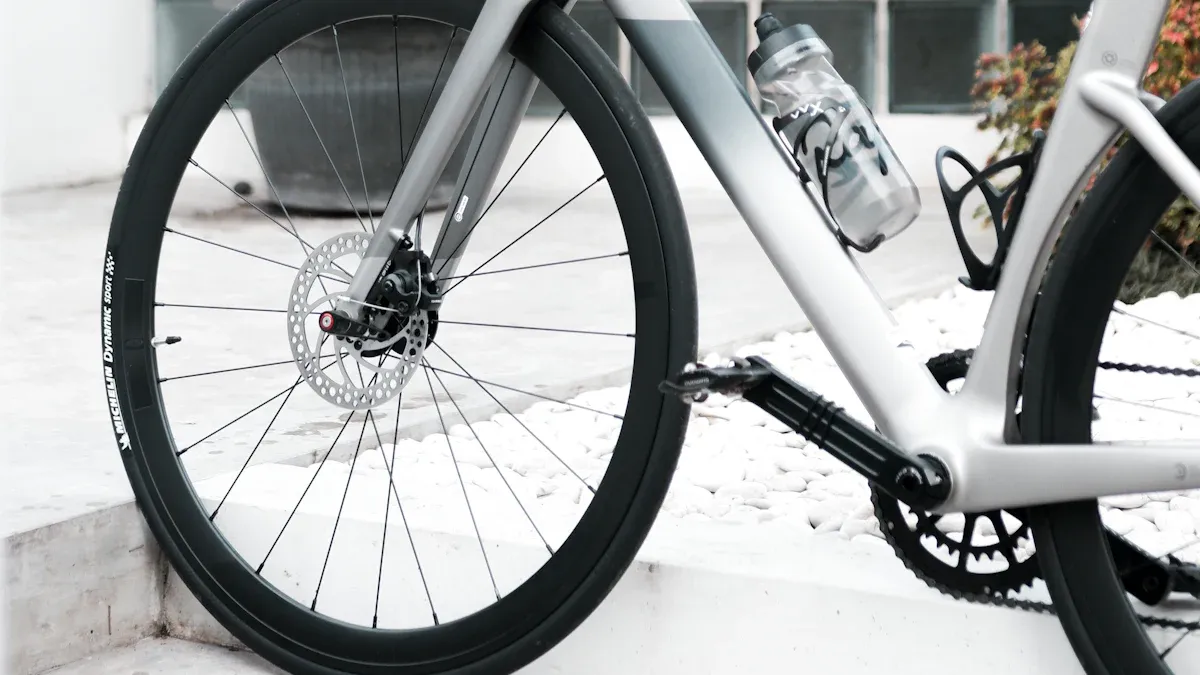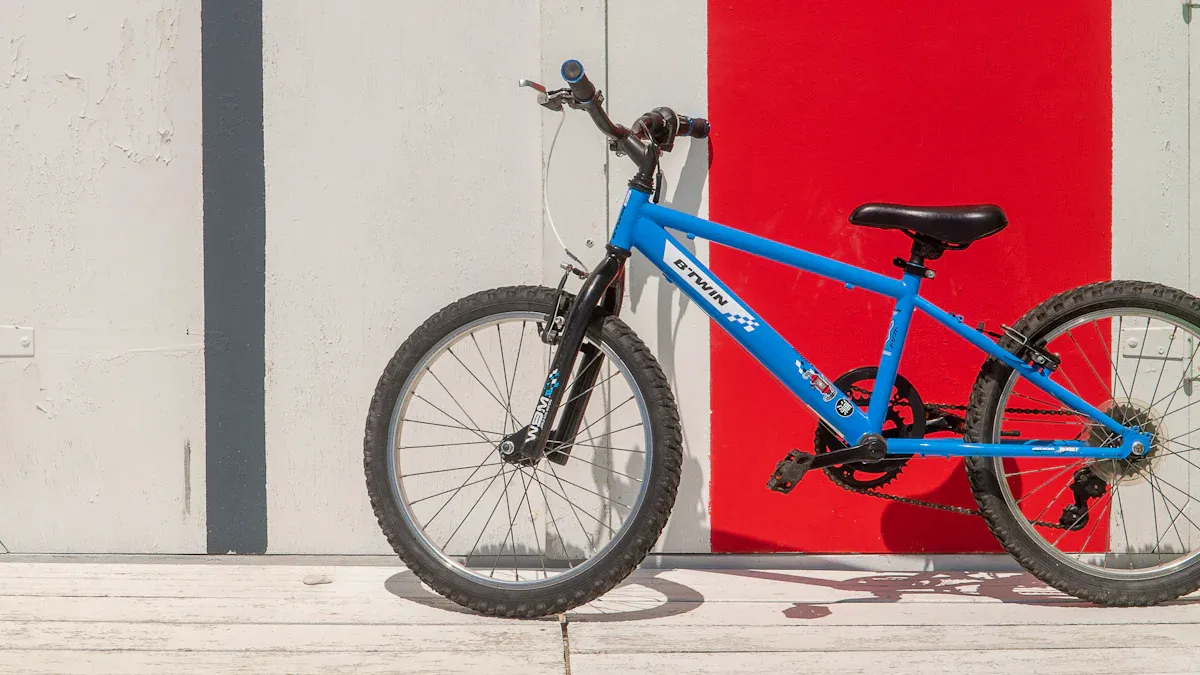
Choosing the best mountain bike frame material in 2025 is very important. Technology has improved a lot. Now, materials like carbon fiber are becoming popular. This material is strong and light. It is great for racing and climbing steep hills. Many riders feel better performance and happiness. The material you pick affects your bike’s performance, comfort, and how long it lasts. Whether you ride for fun or are very serious, knowing the good and bad sides of different bike frame materials can help you make the best choice for you.
Key Takeaways
Carbon fiber frames are light and strong. This makes them great for racing and climbing hills.
Aluminum frames are cheap and light. This is why many riders choose them for good performance on a budget.
Steel frames are very strong and comfortable. They work well on tough trails, but they are heavier than other types.
Titanium frames have the best parts of steel and aluminum. They are strong and comfortable, but they cost more.
Think about how you ride, your budget, and what you want from your bike. This will help you pick the right frame material for your biking adventures.
Carbon Fiber Frame Material

When you think about mountain biking, carbon fiber frames are known for their great performance. Let’s look at the good and bad sides of this popular frame material.
Carbon Fiber Pros
High Stiffness-to-Weight Ratio: Carbon fiber bike frames are very light and strong. This mix helps you speed up fast and climb steep hills easily. Recent studies show that carbon fiber frames are better than aluminum, steel, and titanium for stiffness-to-weight ratio. This means you get a lighter bike that is still strong.
Performance Benefits: Here are some important performance benefits that pro mountain bikers often mention:
Performance Benefit
Description
Exceptional Lightness
Carbon fiber frames are much lighter than aluminum, which helps with speed and climbing.
Strategic Stiffness
Different stiffness helps with power transfer and flexibility where needed in the frame.
Road Vibration Dampening
The material soaks up vibrations, making long rides less tiring and uncomfortable.
Complex Shape Possibilities
Carbon fiber can be shaped into smooth designs that help with efficiency, unlike aluminum.
Resistance to Fatigue
Carbon fiber frames stay strong over time, making them last longer.
Durability: Thanks to new manufacturing methods, carbon fiber frames now have better resistance to wear. Using carbon nanotubes makes them last longer, making them a top choice for high-performance bikes.
Carbon Fiber Cons
Even though carbon fiber frames have many benefits, they also have some downsides:
Cost: One of the biggest problems is the price. Carbon fiber frames can be very expensive. For example, a carbon fiber hardtail might cost between $2,000 and $4,000, while a full suspension model can cost from $3,000 to $6,000. This price can be too high for many riders.
Impact Resistance: While carbon fiber frames are strong, they can get damaged from hard hits. In tests, carbon fiber shows better impact resistance than aluminum and steel, but it can still get stress fractures over time. You need to be careful with your bike to avoid damage.
Repairability: If you do damage a carbon fiber frame, fixing it can be hard and expensive. Unlike aluminum or steel, which can often be bent back, carbon fiber may need special repair methods.
Aluminum Bike Frame Materials

Many riders choose aluminum bike frames for mountain biking. They are a good mix of weight, cost, and performance. Let’s look at the good and bad sides of aluminum frames to see if they are right for you.
Aluminum Pros
Lightweight: Aluminum frames are lighter than steel but heavier than carbon fiber. They are a good choice for those who want a bike that is easy to handle and not too expensive. Aluminum frames are often liked for being light, which helps with climbing and fast rides.
Affordability: One big plus of aluminum bike frames is their price. You can find good aluminum frames for $600 to $1200. This is much cheaper than carbon fiber frames, which start at $1500 and can go up to $3000 or more. This makes aluminum a smart choice for riders who want a reliable bike without spending too much money.
Durability: Aluminum frames do not rust. This means they can handle weather better than steel. They also resist everyday wear and tear, making them a practical choice for regular riders.
Aluminum Cons
Even though aluminum frames have many good points, they also have some downsides:
Stiffness: Many riders say aluminum frames can feel stiff, especially on rough trails. This stiffness can make rides feel harsher, which can be uncomfortable on long trips. If you plan to ride on bumpy paths, you might want to upgrade parts like the seatpost or handlebars for better comfort.
Ride Comfort: Users often say aluminum frames can pass vibrations from the trail, which can be tiring over time. Some riders suggest adding carbon or titanium parts to make rides more comfortable. If comfort is important to you, this is something to think about.
Steel Frame Types
When you think about mountain biking, many riders love steel bike frames. They like the special features of these frames. Let’s look at the good and bad sides of steel frames to see if they are a good fit for you.
Steel Pros
Strength and Durability: Steel frames are very strong. They can handle tough trails and heavy use. Many riders believe steel frames last longer than aluminum or carbon fiber. Some sources even say steel can last forever if used gently. This strength makes them a smart choice for serious bikers.
Shock Absorption: Steel frames can absorb some shocks. They are not as good as carbon fiber, but they give a smoother ride than aluminum. This helps reduce tiredness on long rides. Here’s a quick look at how different materials absorb shocks:
Material
Shock Absorption
Carbon Fiber
Excellent
Aluminum
Good
Steel
Moderate
Comfort: Steel has a natural flex that makes rides more comfortable on bumpy trails. You will feel less vibration compared to aluminum frames. This can make your rides more fun, especially on rough paths.
Steel Cons
Weight: One downside of steel frames is that they are heavy. On average, steel frames weigh between 3 to 10 pounds. This is heavier than aluminum (3 to 4 pounds) and carbon fiber (about 2 pounds). If you want a light bike for racing or climbing, steel might not be the best choice.
Corrosion: Steel is strong, but it can rust if not cared for. You need to maintain your frame to keep it in good condition. Regular cleaning and using protective coatings can help stop rust.
Cost: Steel frames can cost less than carbon fiber but may still be more expensive than aluminum. However, many riders think they are worth the price because of their durability.
Titanium Frame Material
When you think about mountain biking, titanium bike frames are special. They mix the best parts of steel and aluminum. This makes them a favorite for serious riders. Let’s look at the good and bad sides of titanium frames.
Titanium Pros
Durability: People call titanium frames “forever bikes” because they last a long time. They don’t get tired or rust like steel. This makes them a smart choice for long-term use.
Lightweight: Titanium frames are lighter than steel. This gives you a fast and easy ride. They weigh about half as much as steel for the same part. To make them as stiff as steel, you might need more titanium, which can balance the weight. Still, they are lighter than steel overall.
Comfort: Titanium is great at reducing vibrations. This means you can have a smoother ride on rough trails. You’ll feel less tired on long rides, so you can enjoy your adventure more.
Low Maintenance: Unlike aluminum, titanium doesn’t need special coatings. This makes it easier to take care of your bike. You can ride more and worry less about maintenance.
Titanium Cons
Cost: One big downside of titanium frames is their price. They usually cost between £2,200 and £6,500, which can be too much for many riders. They are a good value over time, but the starting price is high compared to aluminum or steel frames.
Weight Considerations: Even though titanium is lighter than steel, it is still heavier than aluminum. If you want the lightest bike for racing, aluminum might be better. But titanium gives a good mix of weight and strength.
Stiffness: Titanium is strong for its weight, but it might not be as stiff as carbon fiber. This can change how power is transferred during tough rides. Riders wanting the best performance should think about this.
Factors in Choosing Frame Material
When you pick the right mountain bike frame material, think about several things. Your riding style, budget, and performance goals are very important for making the best choice.
Riding Style Considerations
Your riding style affects the frame material you should pick. Different materials have special benefits for different biking experiences. Here’s a quick look:
Material | Key Characteristics | Best For |
|---|---|---|
Steel (Chromoly) | Strong, comfy, easy to fix, but heavier. | Touring bikes, bike-packing, commuters, and classic road bikes where strength and comfort matter more than being light. |
Aluminum | Light, very stiff for good power transfer, doesn’t rust, and is cheap. Can feel rough on bumpy surfaces. | Entry-to-mid-level road and mountain bikes. A great choice for high performance on a budget. |
Carbon Fiber | Super light and very flexible. Very strong, but costly and can break from sharp hits. | High-performance road, gravel, and mountain bikes where being light and tuned performance are most important. |
Titanium | Mixes the lightness of aluminum with the comfort and strength of steel. The main downside is its high price. | Premium, custom-built bikes for serious riders wanting a long-lasting ride quality. |
If you like cross-country riding, you might choose aluminum or carbon fiber for their lightness and performance. If you enjoy downhill trails, steel or titanium could give you the strength and comfort you need.
Budget Implications
Your budget is another key point when picking a mountain bike frame material. In 2025, most mountain bike buyers have an average budget under $4,000. Here are some facts about how budget affects material choice:
Most bikes cost less than $2,000.
Budget mountain bikes usually use aluminum alloy frames for their strength, weight, and cost-effectiveness.
Aluminum alloy frames are popular for budget bikes because they balance strength, weight, and responsiveness well.
Interestingly, 57.1% of mountain bikers in recent surveys picked aluminum mainly for its lower price. This makes it a favorite among riders wanting quality without spending too much.
Performance Goals
Your performance goals also help decide the frame material you should think about. Whether you want speed, strength, or comfort, different materials can help you reach your goals. Here are some important points to consider:
Aluminum 6061 is seen as a better material for rider comfort compared to Medium Carbon Steel and Titanium.
A recent survey showed that saddle design is the most important for comfort, followed by the frame and handlebars.
Riders often know that the frame material affects comfort a lot. Research shows that materials and frame shape influence stiffness, which directly impacts how comfy your ride will be.
Picking the best mountain bike frame material is very important for how you ride. Each type has good and bad points:
Steel: Strong and easy to fix but heavy and can rust.
Aluminum: Light and cheap but might feel rough on bumpy trails.
Carbon Fiber: Great for performance but may not last long with heavy use.
Titanium: Very strong and smooth but costs a lot.
Think about your budget, riding style, and the kind of trails you ride. Trying out different materials can help you find the best one for your adventures! 🚴♂️
FAQ
What is the best frame material for beginners?
Aluminum frames are usually the best for beginners. They are light, affordable, and strong. They are also easy to ride and take care of, which is great for new riders.
How do I know if a frame is durable?
To check if a frame is durable, look at the material and how it’s made. Steel and titanium frames are known to last a long time. You can also read reviews from other riders to see how well a frame holds up.
Can I repair a damaged carbon fiber frame?
Fixing a carbon fiber frame can be hard and expensive. If you break it, talk to a professional who knows how to repair carbon. They can check the damage and suggest the best way to fix it.
How does frame material affect ride comfort?
The material of the frame affects how bumps feel while riding. Steel and titanium can absorb shocks better, giving you a smoother ride. On the other hand, aluminum can feel stiff, which might make rides uncomfortable on rough paths.
Is it worth investing in a titanium frame?
Yes, if you want a bike that lasts a long time and is light with great comfort. Titanium frames can be expensive, but they are strong and need less care, making them a good choice for serious riders.
See Also
Comparing Enduro Bike Frame Materials For Durability And Strength
Understanding The Science Of Compliance In Mountain Bike Frames
Transitioning From Lugged Steel Frames In Mountain Bike Design
Key Factors To Consider When Selecting An E-Mountain Bike Frame
